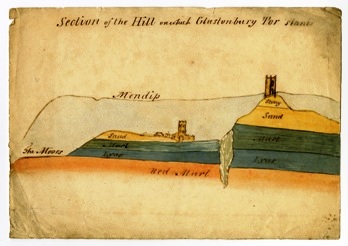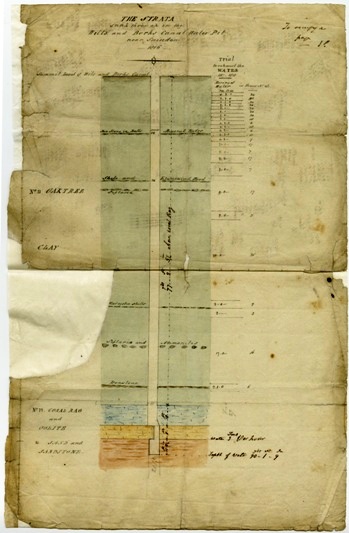In the year that commemorates the bicentenary of the publication of William Smith's famous map, a new on-line archive and website is providing an unparalleled insight into the life of the man whose map changed the world. Nina Morgan and Kate Santry logged on to reveal what's there.
 As a geologist, William Smith was a keen observer and a hard worker, and as a person he possessed many admirable qualities. But organisation wasn't one of them, a fault Smith himself recognised. "It will be seen by these and many other of my successes that I have lived long enough to see the folly of living for ever as a Philosopher" Smith wrote wistfully in a preface to a collection of notes and musings he compiled in preparation for writing his autobiography. Smith himself never completed the project. Instead, the job of documenting Smith's life and achievements was taken up after his death by his nephew, the geologist John Phillips, first professor of geology at Oxford University, first keeper of the Oxford University Museum of Natural History (OUMNH), and a great champion of his uncle's achievements.
As a geologist, William Smith was a keen observer and a hard worker, and as a person he possessed many admirable qualities. But organisation wasn't one of them, a fault Smith himself recognised. "It will be seen by these and many other of my successes that I have lived long enough to see the folly of living for ever as a Philosopher" Smith wrote wistfully in a preface to a collection of notes and musings he compiled in preparation for writing his autobiography. Smith himself never completed the project. Instead, the job of documenting Smith's life and achievements was taken up after his death by his nephew, the geologist John Phillips, first professor of geology at Oxford University, first keeper of the Oxford University Museum of Natural History (OUMNH), and a great champion of his uncle's achievements.
Picture - Smith's Glastonbury cross-section
Phillips, who was raised and trained in geology by Smith, served as Smith's literary and de facto scientific executor, and after Smith's death undertook to "perform the duty of examining his [Smith's] voluminous unpublished papers" after Smith's death. Memoirs of William Smith LL.D. author of the "Map of the Strata of England and Wales" by his nephew and pupil, John Phillips, F.R.S., F.G.S., published by John Murray in 1844, was the first biography of William Smith to appear. Although Phillips admits in the preface to the Memoirs that he took advantage of his biographer's privilege and "softened the darkest outlines of Mr. Smith's private and personal fortunes, because, though to others they seemed very melancholy, by himself they were only regretted as impediments in his adventurous enterprise" Phillips' book remains the most comprehensive account of Smith's achievements published so far. But thanks to modern digitisation and internet technology that may be about to change.
Archive unlocked
 Picture: Smith's Northumberland section.
Picture: Smith's Northumberland section.
Although Phillips, by his own admission, destroyed many of Smith's old letters, he did retain and store many of his uncle's personal papers, diaries, correspondence, professional papers, geological notes, publications, maps and geological sections. This archive remained undisturbed until the late 1930s, when it was rediscovered by Professor Leslie Reginald Cox (1897-1965), a researcher at the Natural History Museum in London, in the OUMNH attic. It is thanks to Phillips' foresight and Cox's rediscovery that OUMNH is now home to the largest documented Smith collection in the world.
In spite of the fact that the Smith material in the OUMNH archive has long been available by appointment to researchers it was never fully catalogued to a professional standard. And because archival material is fragile and irreplaceable handling has necessarily been restricted. Now, thanks to a grant from the Designation Development Fund of Arts Council England, the Smith material is being made available to the wider world. An ambitious archiving and digitisation programme carried out the OUMNH is already making large amounts of its Smith archive available for study to anyone with an internet connection via the website www.williamsmithonline.com. "Projects like this not only help to preserve fragile items in archives," says Paul Smith, Director of OUMNH, "They also make important historical material accessible to the public at large. The archive is as important for those interested in social history as it is for geologists and historians of science."
WilliamSmithOnline – one of many Smith Bicentenary activities and projects planned for 2015 [see text box: What's on] – began in January 2013 after OUMNH obtained funding through Arts Council England to create the website www.williamsmithonline.com. As part of the project the entire OUMNH Smith archive collection is being catalogued to the International Standard of Archival Description [ISAD(G)] and much of its contents scanned. So far, high resolution scans of over 700 letters, 20 diaries, 200 geological sections and 100 maps have been created. A new comprehensive and searchable online catalogue, OUMNH Collections Online, is already available in beta format to replace separate, flat and text-based catalogues.
The WilliamSmithOnline website – which is still being added to – was launched in 2014 on 23 March, William Smith's birthday, with a series of weekend events including a stakeholders’ reception, collectors’ dinner, private and public tours, and talks and demonstrations. The weekend was such a success that William Smith Day will now be celebrated at OUMNH each year. A special series of events to highlight Smith's life and legacy – including an exhibition entitled Handwritten in Stone – is also planned for 2015.
Something for everyone
For members of the public interested in discovering more about the Father of English Geology and the origin of the Smith collection, the website offers general information about William Smith, the man and the geologist, and includes a brief biography, a timeline outlining Smith's accomplishments in the context of events taking place in the world around him, a map showing locations he visited and a bibliography for further reading. Also included are a list of some of Smith's most notable publications and manuscripts with links to pdfs of those available in the OUMNH collections; a page explaining the fundamentals of geological mapping; a discussion of the influence Smith's map had on the history and development of geological mapping; and information about modern developments in geological mapping. There is also a zoomable high resolution scan of Smith's famous 1815 map itself, and a blog titled Handwritten in Stone, where Smith scholars comment on various aspects of Smith's research, life and times in more detail.
For researchers, the website opens the doors to a detailed a fully searchable catalogue that provides easy access to high resolution scans of a majority of the items in the archive at the click of a mouse.
Crowd sourcing
"Website projects like this can never be said to be 'finished'. There is a lot more we hope toadd in the future," says Sarah Joomun, who served as digitisation assistant for the website project. "We rely on interest from the public and offers of voluntary help to make it grow." An on-line transcription programme on the website offers opportunities anyone interested to contribute to the greater understanding Smith and his legacy while at the same time helping to improve the searchability of the online catalogue. "You don't need to be an expert to make a valuable contribution," she says. "All you need is some time, patience, an eye for deciphering 18th C handwriting – and an interest in helping to bring William Smith's achievements back to life."
What's on
For a regularly updated list of Smith-related activities see: William Smith Bicentenary . From March to September 2015, in addition to its permanent William Smith exhibit, the Churchill and Sarsden Heritage Centre located in Churchill, near Chipping Norton, Oxfordshire, the village where Smith was born, will host a special William Smith exhibit from March to September 2015. The exhibit will be curated by OUMNH and will include objects from OUMNH William Smith Collection. For more information see http://www.churchillheritage.org.uk/William_Smith.htm
Acknowledgments

OUMNH acknowledges funding from the Arts Council England Designation Development Fund, and the many Smith collectors and enthusiasts who have provided input to this project.
Picture: Smith's stratigraphic column, Wilts and Berks Canal, near Swindon
Further reading
John Phillips' book Memoirs of William Smith, LLD, was reprinted, with additional material by Hugh Torrens, by The Bath Royal Literary and Scientific Institution in 2003 (ISBN 0954494105). A pdf of the original 1844 edition of the Memoirs is available online at: https://archive.org/details/memoirsofwilliam00philrich
Nina Morgan is a geologist and science writer based near Oxford. Kate Santry is the Head of Archives and Library at the Oxford University Museum of Natural History.